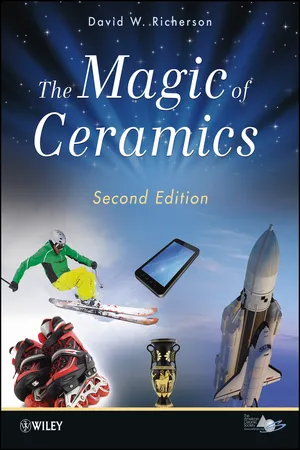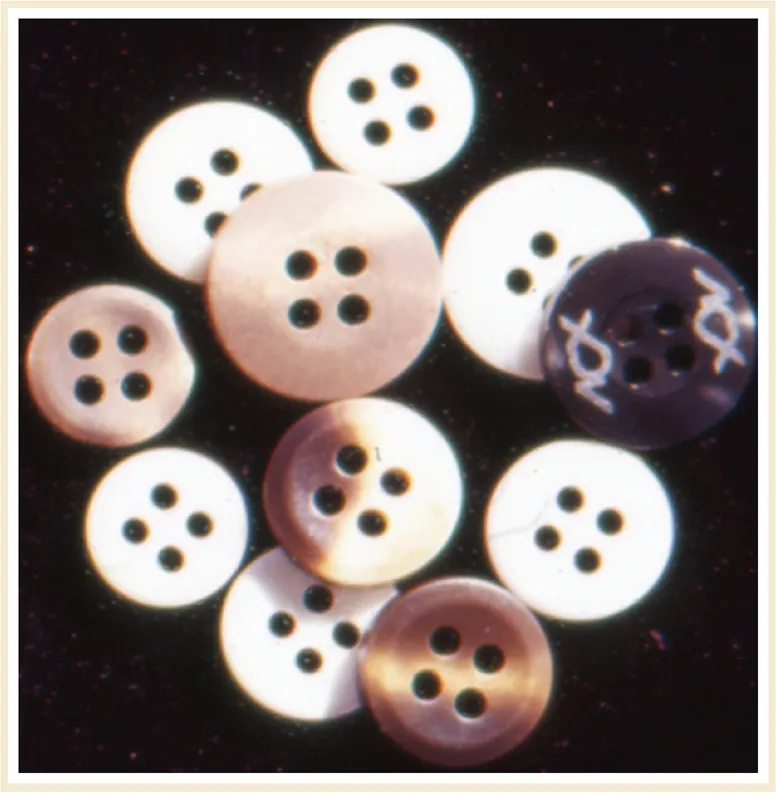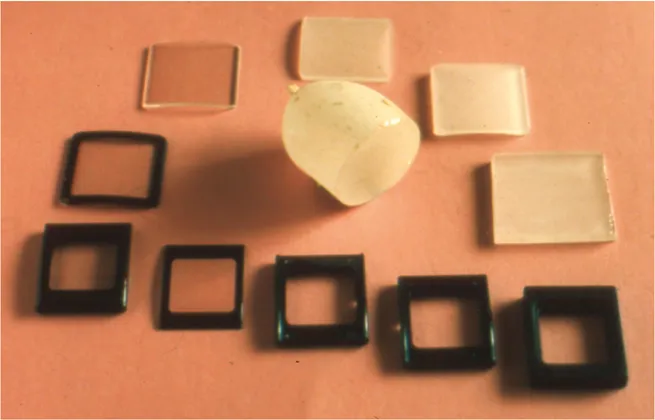
This is a test
- English
- ePUB (mobile friendly)
- Available on iOS & Android
eBook - ePub
The Magic of Ceramics
Book details
Book preview
Table of contents
Citations
About This Book
Most people would be surprised at how ceramics are used, from creating cellular phones, radio, television, and lasers to its role in medicine for cancer treatments and restoring hearing. The Magic of Ceramics introduces the nontechnical reader to the many exciting applications of ceramics, describing how ceramic material functions, while teaching key scientific concepts like atomic structure, color, and the electromagnetic spectrum. With many illustrations from corporations on the ways in which ceramics make advanced products possible, the Second Edition also addresses the newest areas in ceramics, such as nanotechnology.
Frequently asked questions
At the moment all of our mobile-responsive ePub books are available to download via the app. Most of our PDFs are also available to download and we're working on making the final remaining ones downloadable now. Learn more here.
Both plans give you full access to the library and all of Perlego’s features. The only differences are the price and subscription period: With the annual plan you’ll save around 30% compared to 12 months on the monthly plan.
We are an online textbook subscription service, where you can get access to an entire online library for less than the price of a single book per month. With over 1 million books across 1000+ topics, we’ve got you covered! Learn more here.
Look out for the read-aloud symbol on your next book to see if you can listen to it. The read-aloud tool reads text aloud for you, highlighting the text as it is being read. You can pause it, speed it up and slow it down. Learn more here.
Yes, you can access The Magic of Ceramics by David W. Richerson in PDF and/or ePUB format, as well as other popular books in Technology & Engineering & Materials Science. We have over one million books available in our catalogue for you to explore.
Information

Chapter 1
Our Constant Companions
It’s hard to imagine the tremendous role that ceramics play in our everyday lives. Ceramics come in nearly infinite forms and behave in equally diverse ways. Nearly everything we do brings us in contact with either ceramics or something that was made using ceramics. In fact, ceramics are virtually our constant companions; they affect our daily lives in ways that border on magic. If you think of ceramics only as decorative materials or “the stuff that dishes and toilets are made of,” you’re overlooking an important part of your world.
PRODUCTS AND USES
Brick, block, cement
Electrical insulators
Television parts
Watch, clock parts
Windows, mirrors
Knickknacks
Magnets
Dishes, glasses
Lightbulbs
Water faucet seals
Toilets, sinks
Ingredients in cosmetics
Knife and scissors blades
Computer, printer parts
Sporting goods
Buttons
Wall and floor tiles
From Stoneware to Superconductors
What, exactly, are these remarkable materials that have such an effect on our lives? One highly regarded professor and author (W. David Kingery, in his classic text Introduction to Ceramics) defines ceramics as “the art and science of making and using solid articles which have as their essential component, and are composed in large part of, inorganic, nonmetallic materials.” Simply stated, most solid materials that aren’t metal, plastic, or derived from plants or animals are ceramics.
As you might imagine from this definition, the term ceramics covers much ground: from traditional ceramics such as pottery, tile, and glass that date from antiquity to amazing new advanced ceramics that sport strange names such as silicon nitride, aluminum oxide, and cordierite. Even synthetic gemstones such as ruby, sapphire, and cubic zirconia are ceramics. What would we do without glass or bricks or concrete? Although these traditional ceramics have been used for centuries, they are still a vital part of our lives. They’re everywhere we look. Even advanced ceramics have entwined themselves in our daily lives in an incredible number of hidden, and often magical, ways. To initiate your entry into the world of ceramics, let’s take a ceramic tour of your own everyday world. You may find it surprisingly familiar. I hope you’ll then join me for a more in-depth look into the magic of ceramics.
Ceramics in Your Home
Wake-Up Call
Good morning! If your world’s anything like mine, ceramics just woke you from a peaceful sleep. Chances are, your clock or clock radio has an alarm buzzer made from an advanced piezoelectric ceramic. This unusual ceramic vibrates with a loud noise when electricity is applied. If your clock has a quartz mechanism, as most clocks and watches now do, a tiny slice of vibrating piezoelectric quartz ceramic is the timekeeper. However, in this case, the vibrations are so rapid and small that you can’t hear them. Most people have never heard of piezoelectric ceramics, but piezoelectrics are the secret behind a wide variety of products ranging from underwater sonar (submarine searchers) to medical ultrasonic scans to “smart” skis. The secrets of these and other surprising piezoelectric applications are presented in Chapter 7.
Does the face of your alarm clock glow? This glow also may be due to a ceramic, one with the exotic name electroluminescent. The glow is caused by electricity passing through a very thin film of this special ceramic. The clockmaker can control even the color of the glow by selecting the presence of certain atoms in the ceramic. Electroluminescent ceramics also light the instrument panel in your car, the face of many wristwatches, and your cellular phone. Electroluminescence and other ways by which ceramics interact with light or produce light are described in Chapter 4.
Perhaps you prefer to awaken to the sound of soft music from your clock radio. The radio itself is full of ceramic electrical devices (capacitors, insulators, resistors), all working together to soothe you or get you on your feet.
Before you jump out of bed, though, just lie there a minute, stretch your muscles, and survey your room to begin our tour. Note the glass mirror on the dresser and, possibly, the porcelain drawer knobs. Glass also may shield numerous pictures on your walls. The early morning sun streams in through your glass windows, and decorative glass covers your overhead lighting. The light bulbs in your nightstand lamps are glass, as are the vase on the table in the corner and the bottles of colognes, cosmetics, and lotions on your vanity. Although you can’t see inside your bedroom walls, the studs are covered with ceramic plasterboard, and the electrical outlets and lights have hidden ceramic insulators (Figure 1-1). Some of the wall paint even contains ceramic pigments. Flip on the bedroom TV, if you have one, to catch the morning news. Your television is loaded with ceramic parts including the glass screen, the ceramic phosphors that produce the color, and numerous capacitors, insulators, resistors, and integrated circuits (we’ll discuss all these in the later chapters).

FIGURE 1.1 Ceramic electrical insulation such as that used in houses and buildings. Photograph courtesy of Rauschert Industries, Inc., Madisonville, TN.
Well, it’s time to drag yourself to the shower to freshen up. What do you see in the bathroom? More ceramics. As a matter of fact, your bathroom probably has more pounds of ceramic per square foot than any other room in your house. The mirrors and lights are glass. The toilet and sink are ceramic, and the tub is lined with porcelain enamel or constructed completely from glass-fiber-reinforced plastics. The floor, the counter around the sink, and the whole shower/tub compartment may be protected by colorful ceramic tiles. Besides offering beauty, these tiles provide an easy-to-clean surface that has dramatically improved sanitation and health. Ceramic tile has become so universally accepted that enough ceramic tiles are manufactured in the world each year to pave a road the width of three football fields encircling the entire Earth.
Like the bedroom, the bathroom also contains hidden ceramics. The water faucet valve (Figure 1-2) that mixes hot water with cold and also seals against leaks is probably ceramic. The thermal and electrical insulation, and maybe even the heating element, in your hair dryer and in the space heater for cold mornings are ceramic. If you have an ultrasonic denture cleaner, the source of vibration is another piezoelectric ceramic. Even your electric toothbrush might contain ceramics doing their hidden magic. Surprisingly, ceramic powders may be hiding in some of your cosmetics, too. For example, boron nitride is commonly added to facial makeup. Boron nitride, which is white like talcum powder (also ceramic), is made up of tiny flat particles that smear onto a surface (such as your face) to produce a smooth, soft texture.

FIGURE 1.2 Ceramic water faucet seals manufactured by Saint-Gobain/Carborundum Structural Ceramics, Niagara Falls, N.Y.
Source: Photograph by D. Richerson.

After showering and shaving, you may return to the bedroom to dress. The buttons on your shirt or pants could be ceramic (Figure 1-3). If so, they can withstand the most active person and the most abusive laundry situations. The stones in your rings may be cubic zirconia or even synthetic ruby or diamond. Do you wear eyeglasses and a wristwatch? Your watch, like your clock, most likely has a glass cover, an electroluminescent dial, a quartz piezoelectric mechanism, a piezoelectric alarm, and even a lithium battery containing ceramics. If it’s a digital watch, it has a liquid crystal display (LCD, not ceramic) sandwiched between special protective glass layers. Your watch is a marvel of miniaturization and precision. You may be lucky enough to have a special watch such as those made by the Rado company (Figures 1-4 and 1-5), with a cover glass fabricated from synthetic sapphire and its bezel and wristband links shaped from a special new ceramic called transformation-toughened zirconia (another ceramic that we’ll discuss later). Such watches are nearly scratchproof and works of art.

FIGURE 1.3 Ceramic buttons manufactured by CoorsTek, Golden, CO.
Source: Photograph by D. Richerson.

FIGURE 1.4 Beautifully crafted Rado watch fabricated mostly from ceramics. Photograph courtesy of the Rado Watch Co., Ltd., Lengnau, Switzerland.

FIGURE 1.5 Steps in the fabrication of the watch glass and bezel of a Rado watch. Samples courtesy of the Rado Watch Co., Ltd., photograph by D. Richerson.
As you leave the bedroom and enter the hall, you may pass your children’s rooms and perhaps another bathroom. Unless you’re braver than I or you have to venture in to wake the kids, you may want to use your already broadening knowledge to imagine the ceramics buried among their backpacks, shoes, and days-old laundry. In the hall, you should pass a smoke detector and perhaps a carbon monoxide detector. The indicator lights on both the life-saving devices are made of light-emitting ceramic parts, and the sensor in the carbon monoxide detector is ceramic.
Food for Thought
Time for breakfast, at last! Your kitchen is positively loaded with ceramics: drinking glasses, dishes, storage cont...
Table of contents
- Cover
- Title
- Preface & Acknowledgments for the First Edition
- Preface & Acknowledgments for the Second Edition
- Foreword to the First Edition
- Introduction
- Chapter 1: Our Constant Companions
- Chapter 2: From Pottery to the Space Shuttle
- Chapter 3: The Beauty Of Ceramics
- Chapter 4: Ceramics and Light
- Chapter 5: Amazing Strength
- Chapter 6: Ceramics and the Electronics Age
- Chapter 7: Piezo Power
- Chapter 8: Medical Miracles
- Chapter 9: Ceramics and the Modern Automobile
- Chapter 10: Heat Beaters
- Chapter 11: The Hardest Materials in the Universe
- Chapter 12: Energy Conservation and Conversion Efficiency
- Chapter 13: From Pollution Control to Zero Pollution
- Chapter 14: What’s New and What’s Coming
- Conclusion
- About the Author
- Index